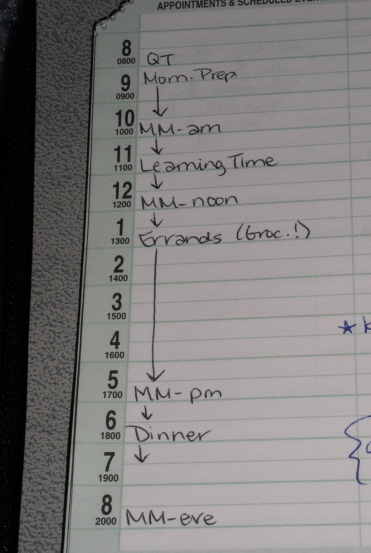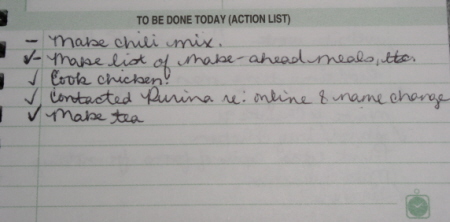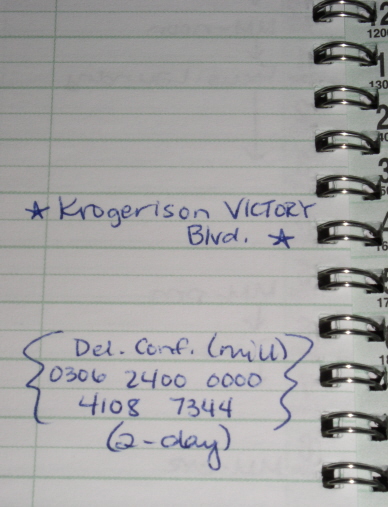Let’s start with the photo from the last post as a frame of reference.

(Larger pic.)
Appointments:
The upper left section is where I write in appointments. This includes anywhere I have to be, of course, but it also includes anything that I have scheduled into my day – anything that is supposed to be done at a particular time. (I am not always consistent about this, but I’m getting better!)

It is important, especially for those of us without a terrific sense of time, to physically block out all of the time taken up by an activity, including travel time, etc. At the same time, I don’t want to get confused about what time I have to actually be someplace. The way I accommodate this is to write in my appointments at their start times. Then I use arrows to block out all of the associated time. You can see the ongoing times marked in this picture. I don’t have any outside appointments on this particular day, so you can’t see any travel time, but it would just be indicated by an arrow pointing up to the time we have to leave.
For recurring activities, I use abbreviations to cut down on the tedium of writing and rewriting. “QT,” for example, is quiet time. “Morn. Prep.” is probably obvious but, just in case, it’s morning preparation (showering, dressing, etc.). “MM” is an abbreviation for a term I adopted from an internet site a while back (I don’t remember which one, or I would give credit) – “minimum maintenance.” In this case, I’m using very slightly differently from the original use, but it basically refers to the ongoing basic pickup – the minimum maintenance required to keep the mess from taking over the house!
To-Do List:
The to-do list, overall, is fairly self-explanatory. It is a list of things to do. 🙂 There are, however, some important things to note. The only things on this particular to-do list are the things I need/hope to accomplish today. (It is not a place to dump everything I think of that eventually needs to be done.)

(By the way, in case you were wondering, this is the to-do list from the page on the right; it doesn’t go with the appointments closeup, which is from the left page.)
I have a basic marking system that I use to keep track of what is or isn’t done. If I complete the task, it gets a check mark. That’s pretty simple. 🙂 If I reschedule the task, it gets a horizontal line. (This is sort of like drawing an arrow to show it was moved forward, but without worrying with the pointed part of the arrow.) If I worked on it, but didn’t finish it and had to move it forward, I use both. (I selected this list for a closeup because it uses all three of these marks.) I do not mark a to-do item with a line until it has already been written in somewhere else, so if it is still blank, I know it still needs to be dealt with. The only mark that doesn’t show up here is an X. I don’t use that one very often. If I decide that a task doesn’t need to be completed at all – not today or any day – I will mark it with an X.
You may also notice that one of my to-do list items here (“Contacted Purina…”) is in the past tense. If I do something that wasn’t on the list to begin with, I will write it in and check it off. This is not because I am obsessive about making the list! 🙂 It keeps me from looking back over my day (especially on a day that didn’t go as expected, so I had to reschedule most of my original to-do’s) and wondering what on earth I did all day! (This is especially handy when my husband has other priorities for me than I what I had anticipated.) I am not good at consciously prioritizing my tasks but, if you are, there is plenty of room to mark each task with an A,B, or C or a 1, 2, or 3 (or whatever) and still be able to mark it completed.
One more note: if you need to contact someone, it can often be helpful to jot the phone number down along with the task when scheduling it, so you don’t have to look it up.
Notes:
The notes section is the one part of the daily page that I’m still really adjusting to making use of. It’s very “open-ended”; there’s a lot you can do with it.

There are several things I use this section for, or have used it for in the past. The two things I most regularly use it for can both be seen above.
1. It can be used for additional information you need for an appointment on the page. In this case, I usually try to jot the note right beside the appointment to which it applies. (Makes sense, right?) In this example, my note to myself about the location of the supermarket is jotted beside “errands” on the schedule. (This was a new – to me – supermarket, hence the need for the note.) In other cases, I might jot down what I need to take with me, if it’s a fairly short list, write down an address or phone number of the place the appointment is, etc. If one of us is doing something out of the ordinary at church one week (providing special music, preaching, etc.), or if we are expected to bring a covered dish, I might make a note of that.
2. It can be used for notes from telephone calls, provided you don’t have a lot of phone calls in one day with a lot of notes each. In this case, I have jotted down a delivery confirmation number for a replacement of my grain mill, which malfunctioned.
3. Currently (the pages above are a couple months old), I am jotting down what I served for dinner. I put this on the bottom two lines, so it’s consistent.
4. I have been known to use the upper portion (first few lines) for keeping track of how many glasses of water I have drunk in a day.
5. A record could be kept here of what Scripture passage was read in a given day.
As you can see, this space can be used for any number of things. I can usually use it fairly easily for at least 3-4 different things, even. If you are just consistent with which portion of the page you use for certain things, the space can be used as its own sort of “divider” so you know what’s what. (There are also some days when I don’t end up writing anything in the notes section.)
Next time, the monthly calendar…
Product used in this post:

[…] Stay tuned for more (so this page doesn’t get too long )… […]